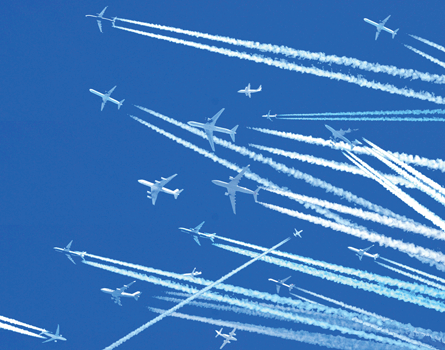Foresight and broad planning could reduce commercial aviation fuel consumption by up to 6% annually. That is more than 3.8 billion litres (1 billion USgal) a year that could be saved, predicts the Partnership for Air Transportation Noise and Emissions Reduction (Partner).
En route traffic optimisation would mean fewer aircraft queueing up in the air needlessly. The plan would assign aircraft the most direct and efficient routes possible using 21st century monitoring and co-ordination, and they would only change speed and direction when necessary, and then only in "small and efficient ways", says John-Paul Clarke, director of the Georgia Tech Air Transportation Laboratory and principal investigator for the fifth project of Partner, which is led by the Massachusetts Institute of Technology.
 |
|---|
© Alisdair Macdonald/REX Features |
Analysing flights to see where inefficient holding patterns and needlessly long routes could be eliminated involved processing a lot of radar data, Clarke says. Airports and the US Federal Aviation Administration had data on which aircraft came and left, but not on their routes.
Primarily, the analysts studied radar from the Cleveland air route traffic control centre. A graduate student then extracted the trajectories for the aircraft that were flying at FL370 [37,000ft/11,300m] and used the trajectory data to create statistics for the rate at which aircraft were entering and leaving points on the boundary of the traffic control centre. "This was an important step," says Clarke, "because, to make sure we had an apples to apples comparison, we had to keep the entry and exit points the same as we allowed the aircraft to depart from the existing route structure to fly the most direct routes."
Operations were then simulated with algorithms embedded to make optimal decisions about heading and speed changes, and the results compared with the existing route structure.
Implementing this plan nationwide would require live co-ordination and in-depth planning to ensure required safety margins.
Dr Lourdes Maurice, chief scientist for the environment in the FAA's Office of Environment and Energy, which is funding the research, adds: "While safety and technical limitations make some transport inefficiencies inevitable, the FAA is aggressively alleviating inefficiencies wherever possible and practical. Partner's research is key to identifying and developing new technologies and procedures that make this possible."
Air traffic congestion is estimated to cost the aviation industry, passengers and shippers a total of $10 billion a year and the situation is expected to worsen given projected aviation growth in the next few years.
Source: Flight International























